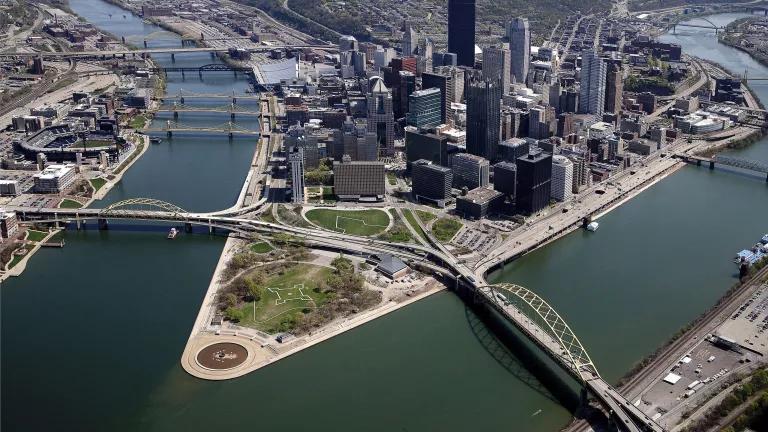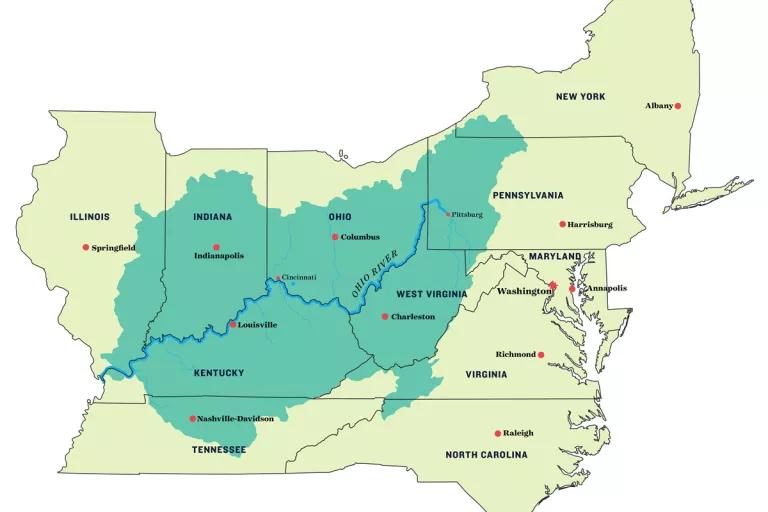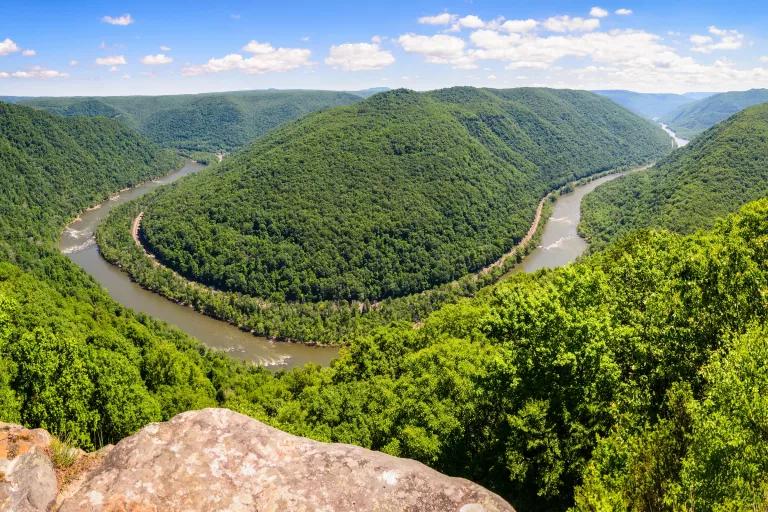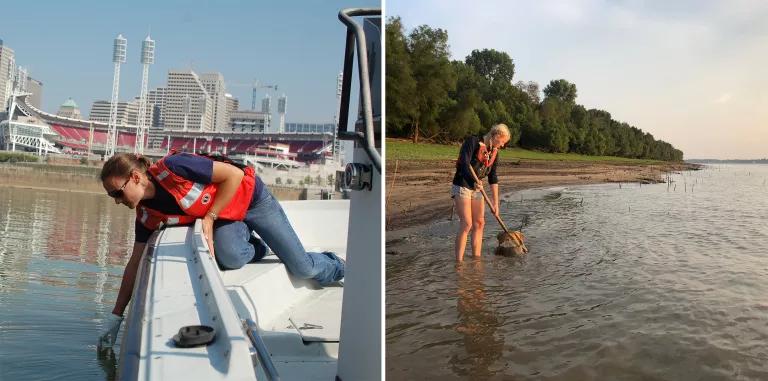The Ohio River Defines the Borders of Five States—But Its Pollution Doesn’t Stop at State Lines
In a move that could open the door to industrial waste and interstate squabbles, the Ohio River Valley Water Sanitation Commission is making its water quality standards voluntary.

The Pittsburgh skyline and Ohio River
Named for an Iroquois word that means “the great river,” the Ohio flows 981 miles southwest from Pittsburgh, Pennsylvania, to Cairo, Illinois, where it sends more water into the Mississippi than any other tributary. Along the way, the Ohio River passes steel factories, farms, and power plants and etches out the borders between Ohio and West Virginia, Ohio and Kentucky, Indiana and Kentucky, and Illinois and Kentucky.
So that means a contaminant that enters the water in Pennsylvania or West Virginia could wind up in Kentucky, Indiana, and beyond. “Eventually, the pollution is going to get to you if you’re downstream,” says John Stolz, a marine microbiologist at Duquesne University in Pittsburgh.
And therein lies the problem with the recent decision by the Ohio River Valley Water Sanitation Commission (ORSANCO) to change the river’s water quality rules. Governor-appointed commissioners from eight states (which also include New York and Virginia) and federally appointed ORSANCO members voted in June to make the current regional water pollution standards voluntary. The change allows the states to adopt varying standards for what industries can discharge into the shared waterway, potentially putting the river—and those who depend on it—at risk. And more pollution is something the Ohio can’t afford.
“It’s really important to maintain the water quality,” says Stolz, who spoke out against the change in April at a public meeting in Pittsburgh. Five million people rely on the Ohio River for their drinking water, and despite decades-long cleanup efforts, the river remains one of the most polluted in the country.

When ORSANCO was created in 1948, the Ohio was even worse. At the time, 99 percent of wastewater from towns and cities along its path went directly into the waterway. “The river was in deplorable condition and an impediment to economic development,” says Richard Harrison, executive director and chief engineer of ORSANCO. The group signed a compact requiring its member states to regulate what entered the Ohio and work together to install wastewater treatment plants. Over time, federal and state water quality laws also became stricter.
At its inception, ORSANCO set pollution standards for contaminants, later adding limits to pollutants such as mercury, which is often discharged by power plants, and nitrates, which regularly wash into waterways from farms. A proposal last year seeking to dissolve those requirements led to public outcry, so ORSANCO opted instead to change them. Though the standards weren’t explicitly required before, they weren’t explicitly voluntary, either—until now.
Environmental groups like the National Wildlife Federation and the Ohio River Foundation say the decision will open the door for pollution from plastics manufacturing and the fracking industry. They also point out that because the water doesn’t stop flowing at one state’s borders, standards should be consistent along the length of the river. Supporters of the move, however, argue that standards under the Clean Water Act make the regional requirements unnecessary. “There’s no weakening of water quality in the Ohio River,” says Rich Cogen, executive director of the Ohio River Foundation and co-chair of ORSANCO’s Watershed Organizations Advisory Committee. “That being said, I don’t think that water quality will improve.”

Some of the ORSANCO standards are more stringent than those established by state regulations or the Clean Water Act. And with the Trump administration rolling back or simply not enforcing many federal environmental protections, many people in the Ohio River Valley are concerned over the proposals to weaken or dissolve the ORSANCO rules. During the public comment period, 4,150 people wrote in to oppose the change; only 9, most from industry, supported it.
States that already have and enforce stricter standards, such as Illinois and Ohio, supported the measure, but others, like Indiana, West Virginia, and Pennsylvania, rely on ORSANCO to set standards. Cogen says those states may not have the resources or personnel to go through the scientific processes to develop, implement, and enforce their own rules, the result being weaker or fewer standards. In Pittsburgh, for example, where the Allegheny, Monongahela, and Ohio Rivers meet, Stolz studies the three rivers and has seen firsthand how shifting state standards can affect downstream waters.
When Stolz started his work in the region in the early 2000s, the Ohio River’s water quality appeared to be improving. Steel mills and other industries along the waterfront were shuttering, and the streams of effluent they emptied into the river were slowing.

By 2005 the water was so clean that Pittsburgh hosted the Bassmaster Classic, a fishing tournament that brought in $13 million from tourism alone. Soon after that, however, testing began to show higher concentrations of total dissolved solids such as salts, minerals, and organic matter that can affect water quality.
“Our Department of Environmental Protection was allowing this new industry called fracking to take their drilling waste to municipal wastewater treatment plants along the three rivers,” says Stolz. Eventually Pennsylvania’s government prohibited fracking waste from being processed at wastewater treatment facilities, and at least in the Allegheny, water quality improved.
For the past three years, Stolz and his colleagues have tested and analyzed samples taken from the rivers to observe changes in water quality as part of 3 Rivers QUEST, a water quality monitoring and reporting program for the Ohio, Monongahela, and Allegheny. They have found that the water has only gotten worse. Stolz suspects the pollution is again coming from the fracking industry, but instead of through water treatment facilities, it’s likely leaching from the ground and contaminated surface water.

What’s happening in the Ohio River’s headwaters is a lesson for why regional oversight and higher standards are so important, he says. “It has to be abundantly clear that the EPA has to be the low bar.” The agency doesn’t limit states from having stricter standards, and in an area where oil and gas extraction by unconventional methods is widespread, Stolz says groups like ORSANCO could help keep water cleaner.
ORSANCO says it will now focus its efforts on monitoring and research alone, which the group has done over the past 70 years. From 20 monitoring stations along the river, scientists from the group analyze the health of aquatic life and water quality. The group used this data to set its standards and will continue to publish the information in its triennial reports. And when there’s a toxic spill, such as when seven barges in Louisville dumped coal into the river last December, ORSANCO has a system in place to detect it.
According to ORSANCO’s Harrison, states still have to protect water quality even if they adopt different standards.“I know the commission would not have made this decision if it were going to have a damaging effect on water quality,” he says.
But for Cogen, a better solution would have been to make the ORSANCO standards mandatory, removing any ambiguity. Then states could have strengthened or weakened the standards after going through a process to opt out of ORSANCO’s baseline pollution limits. Ideally, says Cogen, “having more uniform standards would better benefit the river and river states and the public and drinking water.”
This NRDC.org story is available for online republication by news media outlets or nonprofits under these conditions: The writer(s) must be credited with a byline; you must note prominently that the story was originally published by NRDC.org and link to the original; the story cannot be edited (beyond simple things such as grammar); you can’t resell the story in any form or grant republishing rights to other outlets; you can’t republish our material wholesale or automatically—you need to select stories individually; you can’t republish the photos or graphics on our site without specific permission; you should drop us a note to let us know when you’ve used one of our stories.

Gibbstown LNG Terminal: A Catastrophe Waiting to Happen
A Small Town’s Battle Against Radioactive Fracking Waste
She Breathes In Pollution, and Fights It, in the Windy City